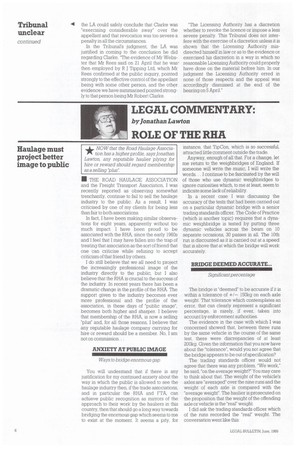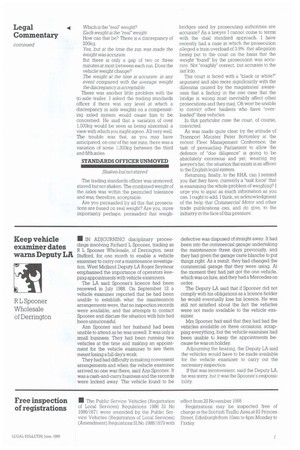LEGAL COMMENTARY:
Page 104

Page 105

If you've noticed an error in this article please click here to report it so we can fix it.
by Jonathan Lawton
ROLE OF THE RHA
Haulage must project better image to public
,,A, NOW that the Road Haulage Associa tion tion has a higher profile, says Jonathan Lawton, any reputable haulier plying for hire or reward should regard membership as a selling 'plus'.
• THE ROAD HAULAGE ASSOCIATION and the Freight Transport Association, I was recently reported as observing somewhat trenchantly, continue to fail to sell the haulage industry to the public. As a result, I was criticised by one of my clients for being less than fair to both associations.
In fact, I have been making similar observations for eight years, apparently without too much impact. I have been proud to be associated with the RHA, since the early 1960s and I feel that I may have fallen into the trap of treating that association as the sort of friend that one can criticise while refusing to accept criticism of that friend by others.
I do still believe that we all need to project the increasingly professional image of the industry directly to the public, but I also believe that the RHA is crucial to the success of the industry. In recent years there has been a dramatic change in the profile of the RHA. The support given to the industry becomes ever more professional and the profile of the association, in these days of "public image", becomes both higher and sharper. I believe that membership of the RHA, is now a selling "plus" and, for all those reasons, I believe that any reputable haulage company carrying for hire or reward should be a member. No, I am not on commission..
ANXIETY AT PUBLIC IMAGE Ways to bridge enormous gap You will understand that if there is any justification for my continued anxiety about the way in which the public is allowed to see the haulage industry then, if the trade associations, and in particular the RHA and FTA, can achieve public recognition as mirrors of the approach to their work by the hauliers in this country, then that should go a long way towards bridging the enormous gap which seems to me to exist at the moment. It seems a pity, for instance, that TipCon, which is so successful, attracted little comment outside the trade.
Anyway, enough of all that. For a change, let me return to the weighbridges of England. If someone will write the music, I will write the words. . I continue to be fascinated by the will of those who use dynamic weighbridges to ignore curiosities which, to me at least, seem to indicate some lack of reliability.
In a recent case I was discussing the accuracy of the tests that had been carried out on a particular dynamic bridge with a senior trading standards officer. The Code of Practice (which is another topic) requires that a dynamic weighbridge is tested by putting three dynamic vehicles across the beam on 10 separate occasions, 30 passes in all. The 10th run is discounted as it is carried out at a speed that is above that at which the bridge will work accurately.
BRIDGE DEEMED ACCURATE...
Significant percentage The bridge is "deemed" to be accurate if it is within a tolerance of +/— 150kg on each axle weight. That tolerance which contemplates an error, that can clearly represent a significant percentage, is rarely, if ever, taken into account by enforcement authorities.
The evidence in the case with which I was concerned showed that, between three runs by the same vehicle in the course of the same test, there were discrepancies of at least 200kg. Given the information that you now have about the "tolerance", would you not agree that the bridge appears to be out of specification?
The trading standards officer would not agree that there was any problem. "We work," he said, "on the average weight?" You may care to think about that. The weight of the vehicle's axles are "averaged" over the nine runs and the weight of each axle is compared with the 'average weight'', The haulier is prosecuted on the proposition that the weight of the offending axle or vehicle is the "real" weight.
I did ask the trading standards officer which of the runs recorded the 'rear weight The conversation went like this: Which is the "real" weight?
Each weight is the "real" weight.
How can that be? There is a discrepancy of 200kg.
Yes, but at the time the run was made the weight was accurate.
But there is only a gap of two or three minutes at most between each run. Does the vehicle weight change?
The weight at the time is accurate: in any event compared with the average weight the discrepancy is acceptable.
There was another little problem with the tri-axle trailer. I asked the trading standards officer if there was any level at which a discrepancy in axle weights on a compensating aided system would cause him to be concerned. He said that a variation of over 1,000kg would be seen as being abnormal; a view with which you might agree. All very well. The trouble was that, as you may have anticipated, on one of the test runs, there was a variation of some 1, 200kg between the third and fifth axles.
STANDARDS OFFICER UNMOVED Shaken but not stirred The trading standards officer was unmoved; stirred but not shaken. The combined weight of the axles was within the permitted tolerance and was, therefore, acceptable.
Are you persuaded by all this that prosecutions are based on real weight? Are you, more importantly perhaps, persuaded that weigh bridges used by prosecuting authorities are accurate? As a lawyer I cannot come to terms with the dual standard approach. I have recently had a case in which the prosecution alleged a train overload of 3.9%: that allegation being put to the court on the basis that the weight "found' by the prosecution was accurate. Not "roughly" correct but accurate to the last kilo.
The court is faced with a "black or whiter argument and also more significantly with the dilemma caused by the magistrates' awareness that a finding in the one case that the bridge is wrong must inevitably affect other prosecutions and they may, Oh woe! be unable to convict other hauliers who have "overloaded" their vehicles.
In this particular case the court, of course, convicted.
As was made quite clear by the attitude of Transport Minister Peter Bottomley at the recent Fleet Management Conference, the task of persuading Parliament to allow the defence of "due diligence" is going to be absolutely enormous and yet, wearing my lawyer's hat, the situation that exists is an affront to the English legal system.
Returning, fmally, to the RHA, can 1 remind you that they have, currently a "task force" that is examining the whole problem of weighing? 1 urge you to input as much information as you can. I ought to add, I think, an acknowledgment of the help that Commercial Motor and other trade publications can, and do give, to the industry in the face of this pressure.












































































































































